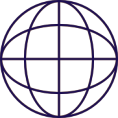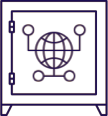Blockchain native digital assets and infrastructure have the potential to disrupt many industries and empower a social-economic revolution – offering one of the greatest investment opportunities of the coming decade.
Vision
The world is facing a decline in trust in centralized organizations. Blockchain as a solution to this challenge, is a technology based on math, cryptography, game theory and incentive models that lead to automated trust, transparency and decentralized consensus.
As the internet is evolving, blockchain technology is unlocking a multi-trillion dollar market opportunity where automated trust, transparency and decentralized consensus are considered as the new cornerstones for the next generation of internet called Web3.
Web3 includes platforms and applications that enable shifts toward a future, decentralized internet with open standards and protocols while protecting digital-ownership rights, providing users with greater ownership of their data and catalyzing new business models.
Web3 is a future ecosystem where a variety of technology innovations like i.e. blockchain, NFT’s and Artificial Intelligence (AI) merge into a digital world also known as the “Metaverse”. In a Metaverse blockchain network(s) will facilitate a transactional environment where users are able to transact, enjoy and benefit from digital assets.
Scalability and interoperability of blockchain networks are vital to successful mass adoption. Many digital assets will exist in future Metaverse’s and that is why digital asets are considered as one of the greatest investment opportunities of the coming decade.

Blockchain as the next generation of the internet (web 3)

Metaverse, NFT’s and GameFi

Blockchain leading to a renaissance of the global financial system

Blockchain as a digital native store of value

Evolution to web 3
Web 1
…refers to the first stage of the World Wide Web evolution. In essence, centralized content creators offered mainly static pages, with most users consuming the content on PCs for free. Web 2 refers to websites that contain user-generated content, usability, and interoperability for end users. Web 2 is also called the participative social web. Centralized platforms own the content and control the interaction between users on a cloud-based and mobile infrastructure.
Web 2
…is characterized by tech giants, data monopolies, and trusted third parties that rule the world, while web 3 is about self-sovereign ownership and control of value and data by Decentralized Autonomous Organizations (DAO’s).
Web 3
…is a permissionless and user-centric version of web 2. It refers to the evolution of web utilization and interaction which includes altering the web into a database. In this, data exists on a decentralized blockchain infrastructure that interacts with networks and protocols. Web 3 enables virtual economies to rise with DAO’s offering decentralized apps (DAPPS). This unlocks a multi-trillion dollar market that is to be compared to the rise of the internet itself in the .com era.

Blockchain interoperability and scalability
An interoperable and scalable Web3 world is the foundation for the future of internet applications. A multichain ecosystem facilitated by seamless cross-chain bridges will get us there and bring that vision to fruition.
Blockchain interoperability refers to a wide variety of methods that enable many blockchains to communicate, share digital assets and data and work together more effectively. This makes it possible for one blockchain network to share its economic activity with another. For example, interoperability allows transmitting data and assets across different blockchain networks via decentralized cross-chain bridges.
For successful mass adoption of blockchain and web3 applications, the ecosystem is required to be secure, decentralised and scalable. To realise a secure, decentralised and scalable infrastructure for the blockchain ecosystem, so called layer 1 platforms and layer 2 solutions are required.
Layer 1 platforms (i.e. the Ethereum network) are a base layer where all transactions are stored and validated. Layer 1 platforms include all native tools and functionalities of a blockchain, including smart contracts, consensus, and security. Layer 1’s are comparable to the original Linux kernel as a fundamental part of the internet as we know today.
Layer 2 solutions are tools and solutions on top of layer 1 networks to make the existing layer 1 solutions faster and more scalable by offloading transactions from the Mainnet or Layer 1 while still harnessing Layer 1’s robust security features.
The key to the success of blockchain technology and Web3 will rely on the level of interaction and integration and on the level of scalability between blockchain networks.

Metaverse, NFT’s and GameFi
Key technologies such as blockchain, cloud computing, virtual reality (VR), augmented reality (AR), and artificial intelligence (AI) are the building blocks of Web3, a decentralized version of the internet that consists of blockchain-enabled applications that support an economy of user-owned assets and data. Web3 is also the foundation of the metaverse: the virtual world in which we’re all predicted to interact with in the future.
One of the most crucial digital disruptions is the rise of non-fungible tokens (NFTs). The term ‘disruption’ has been diluted due to overuse, but it’s truly justified in the case of NFTs – unique digital assets that can represent both internet collectibles and real-world objects. Thanks to blockchain technology, now almost anything in pixels can be tokenized and turned into an NFT. This simultaneously creates digital scarcity and empowers anyone with the ability to create their own digital assets for profit or innovation.
NFT’s open a whole new world of digital commerce, as individual users can create digital assets out of almost anything in pixels and then place the value they want on them.
NFT’s are crucial for the metaverse, as they’re potentially the key to offering interoperability – the ability to buy and use digital products to use across all the future virtual worlds. It empowers your ‘crypto wallet’, which you use to carry cryptocurrencies and your metaverse-only digital goods, such as your avatars, avatar clothing, avatar animations, virtual decorations, and weapons.
One of the most exciting new marketplaces in this world is GameFi, which combines decentralized applications (‘dapps’) with economic incentives in play-to-earn gaming. This allows players to trade, lend, or rent out their winnings or even borrow against them. The winnings are earned from carrying out game-related tasks such as winning battles, mining resources, growing crops, or ‘renting’ out virtual land. The name GameFi merges gaming and DeFi, which is decentralized finance – the fast-growing field in which token-based transactions like lending and borrowing take place on blockchains.

Decentralised finance
One of the first virtual economies based on DAO’s and DAPPS that shows the potential of blockchain is the rise of a new financial system without central institutions, called DeFi (Decentralized Finance).
DeFi is an alternative open financial system with low costs, that is more efficient, borderless, inclusive and transparent than the current financial system. It is able to challenge and disrupt the existing banking system on its core principles to serve and facilitate people’s finance instead of realizing inappropriate gains for the financial institutions themselves.
DeFi offers an unmatched opportunity by potentially disrupting the slow and institutional controlled existing financial system. DeFi is happening as we speak with over $200bn locked in DeFi protocols.
Where Bitcoin can be considered an exit from the Fed, DeFi could be a potential exit from Wall Street.

Digital Native Store of Value
Money is invented to solve the limitations of barter. The key characteristics of good money are scarcity, durability, portability, verifiability, and divisibility. As technology is evolving, the monetary system is too. The internet allows any two individuals to transfer data without permission from any central authority, bitcoin does the same for value.
Bitcoin contains all essential aspects of “hard” money, and the bitcoin network is the biggest maintained and secured network of servers and computers in the world.
Bitcoin is a proven store of value with more than 1 trillion dollar market capitalization. Compared to the 11 trillion dollar market capitalization of gold, Bitcoin still offers significant upside potential. Additionally, the bitcoin network is still developing, and more use-cases that have the potential to create even more value are on the horizon.